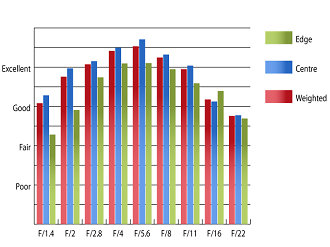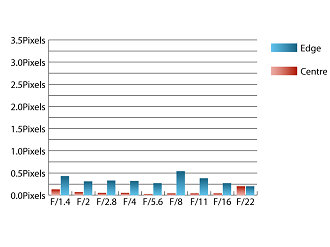Samyang 50mm f/1.4 AS UMC Lens Review
Samyang 50mm f/1.4 AS UMC Performance
At f/1.4, sharpness in the centre of the frame is good, although typically for a lens of this type, performance towards the edges of the frame at maximum aperture is only fair. Stopping down improves sharpness dramatically across the frame, with sharpness approaching excellent levels in the centre by f/2 and excellent clarity being achieved across the frame by f/4.
How to read our charts
The blue column represents readings from the centre of the picture frame at the various apertures and the green is from the edges. Averaging them out gives the red weighted column.The scale on the left side is an indication of actual image resolution. The taller the column, the better the lens performance. Simple.
For this review, the lens was tested on a Canon EOS 5D Mark II using Imatest.
Chromatic aberrations are kept under control, remaining under half a pixel width in size at all apertures. These low levels of fringing should be difficult to spot, even in very large prints, or harsh crops from the edges of the frame.
How to read our charts
Chromatic aberration is the lens' inability to focus on the sensor or film all colours of visible light at the same point. Severe chromatic aberration gives a noticeable fringing or a halo effect around sharp edges within the picture. It can be cured in software.Apochromatic lenses have special lens elements (aspheric, extra-low dispersion etc) to minimize the problem, hence they usually cost more.
For this review, the lens was tested on a Canon EOS 5D Mark II using Imatest.
Falloff of illumination towards the corners is quite strong, as is typical of fast standard lenses. The corners are 2.52 stops darker than the image centre at f/1.4 and visually uniform illumination isn't achieved until the aperture is stopped down to f/4 or beyond.
Imatest detected 2.29% barrel distortion, which is a fairly typical for a wide aperture standard lens like this, but may still become visible in images with straight lines close to the edges. The distortion pattern is uniform across the frame, so should be relatively straightforward to correct in image editing software afterwards.
The multi coatings applied to this lens seem quite effective, suppressing flare and keeping contrast levels reasonable. Strong point sources of light shining into the lens will cause a loss of contrast and plenty of ghosting, but only in extreme examples of this kind of lighting. This lens tends to give a noticeable warm tone to images, and contrast is muted, when compared to other modern lenses, which sometimes produces a look associated with vintage manual focus lenses.
Value For Money
With a price of £379 (£419 in Nikon AE fit), this lens seems quite pricey for a basic lens that does not have electronic coupling to the camera. For example, Canon's standard EF 50mm f/1.4 lens can be picked up for around £270, and Nikon's AF-S 50mm f/1.4G lens is priced at around £280.
However, Sigma's 50mm f/1.4 DG HSM A lens is more expensive, being priced at around £640, so this Samyang lens isn't the most expensive third party option, at least.
Add your message
Please login here or if you've not registered, you can register here. Registering is safe, quick and free.
photodo Stats
428 MTF tests
74 in-depth photodo reviews
100+ users join each day
Help the lens community by reviewing or rating a lens today via our lens search
Latest Lens Reviews
- Chinon 28mm f/2.8 Vintage Lens Review
- Canon EF 70-200mm f/4L IS II USM Lens Review
- Samyang AF 85mm f/1.4 EF Review
- Sigma 70mm f/2.8 DG Macro Art Review
- Samyang AF 24mm f/2.8 FE Review
- Meike 50mm f/1.7 Review
- Tamron 70-210mm f/4 Di VC USD Review
- Lensbaby Burnside 35mm f/2.8 Review
- Asahi Super Takumar 50mm f/1.4 Review
- Asahi Super-Multi-Coated Takumar 135mm f/3.5 Review


